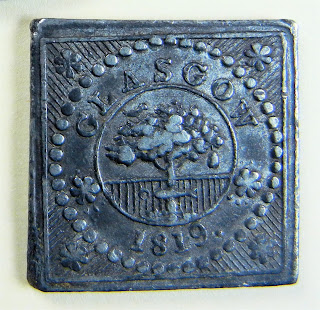Let me introduce you to a CT from Glasgow -- one of my favorites -- that is frequently available in the marketplace for about $20 to $50. This token is a single-sided square with a pair of concentric circles in the center, forming a band, with the legend: GLASGOW 1819. It is a beautiful piece, as it depicts the city crest in full detail with a full complement of ornaments.
 |
| This is one of the most ornate CTs available. It is the last of five tokens in the series and is the best made. |
The crest has more than just the tree. If you examine the CT closely, you will see a fish at the base of the tree, a bell hanging from one of its branches, and a bird atop the crown. These elements are known as the fish that never swam, the bell that never rang, and the bird that never flew. Each has its own legend. These curious elements of the Glasgow crest can be traced separately back to the 13th and 14th centuries, but they all came together in the late 1480s. I urge you to explore this -- it will make you want the token!
This token is part of a series of CTs used in Glasgow, all with the same design and crest. They were produced in 1714, 1716, 1725, 1776 and 1819. It is difficult to tell which church used these particular CTs, as there were several parishes located within the royal burgh. It is likely, but not confirmed, that these CTs were used at the same parish.
In addition to being part of a short series, this CT represents a specific style of token design. The hallmark of this style includes two concentric circles, centered, that forms a band within which a legend is placed. This style became popular across the western midlands in the latter half of the 1700s. In fact, the use of this design peaked in the 1770s and remained popular until a sharp decline after 1832. Sixty percent of them come from Lanark and Ayr in that order. Another 25% of them come from Argyll, Stirling and Renfren. One or two reached east to Angus, Kirkcudbright and Aberdeen. With such a tight geographic distribution, it is not surprising that the style is referred to as the Glasgow square.
Later on, we will track these squares: from Glasgow, to Inchinnan, to Cambuslang, and so on. But for now, go ahead and get one of these Glasgow pieces: The 1819 is widely available.
In case you were wondering: Five of them sold in the past 90 days on ebay with prices ranging from a high of $56 to a very low of $8. One other sold for $16 with the other two trading at $36 and $39.
No comments:
Post a Comment